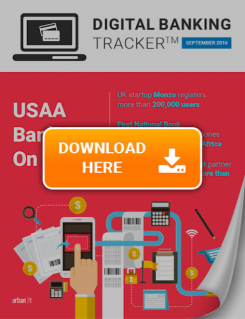USAA Banking On Digital

Requesting app support … Because USAA Bank serves active military members, who are often stationed far from home and cannot visit a branch or readily speak by phone, it’s crucial that the organization delivers a complete and up-to-date set of services to their members. For the latest edition of the Digital Banking Tracker™, PYMNTS caught up with Prianka Advani, assistant vice president of USAA Bank, to discuss the mobile and digital future of the financial services industry. You can find that, along with the latest news from around the space and a directory with profiles of 88 of the biggest players in the Digital Banking industry, in the September Tracker.
There’s no doubting the fact that more and more consumers are embracing mobile and online banking services each day, often enticed by convenient and useful app features.
But how do digital and mobile banking service providers decide just what features are right for their customers?
For Prianka Advani, assistant vice president of USAA Bank, and her team, it comes down to feedback from those customers. The company recently unveiled an updated version of both its web and mobile banking apps, complete with new tools, including an expanded virtual assistant and fraud protection tools.
PYMNTS recently caught up with Advani to discuss USAA’s mobile and online banking solutions and how she and her team update the app in order to keep pace with new technologies and features from competitors in the space (and keep customers happy, too).
Mobile and digital services are especially important for USAA, as the bank serves military members and their families who are deployed across the United States and around the world and often cannot visit a branch or speak over the phone.
“With the military community moving to mobile for most of their needs, we are challenging ourselves to think about how we serve our members digitally first,” she explained. “For our deployed members, for example, it is easier for them to access their banking online than to call in for banking information and transactions.”
Keeping Up With The Siris
USAA seeks to update its mobile and web apps fairly regularly in order to keep the app up-to-date for customers and stay in line with rules from app marketplaces, like Apple and Android, Advani told PYMNTS. Advani said that she and her team are “obsessed with member feedback” and often collect comments from users via digital and mobile channels.
Often, those customer suggestions are inspired by features from other companies, whether they are a service offered by a competitor or feature found on an entirely unrelated product or platform. After companies like Apple had popularized voice-activated virtual assistants, consumers grew accustomed to using their voice to perform simple commands on their phones or computers.
“Members told us they had been using other voice technologies, like the Alexas or Siris of the world, and they wanted to use the voice command to do their banking,” Advani explained. “Today, Alexa and Siri, because of authentication issues, largely aren’t there yet, but our virtual assistant, Eva, is.”
Customers responded well to Eva, Advani said, and it quickly became a favorite feature of the bank’s mobile app and one that members wanted to use on other channels, such as the company’s website. So, in the interest of keeping customers happy and offering them as many options as possible, USAA added to Eva’s list of functions and looked to bring the virtual assistant to other channels, including the USAA website.
USAA is “agnostic” to whatever channel customers are using, Advani said. “We’re focused on making the technology better and better and available to all of our members via different channels. Why should members who use dot-com services lose out on that technology?”
USAA rolled out its updated solutions in early September. Additionally, the bank is already working on new features to include in the next update in order to help members deployed overseas access more banking options, including more updates to the virtual assistant, a wider range of transactions and new notifications to help members keep track of their finances.
“Because of who we serve, active military members and their families, USAA has always made it a priority to provide solutions that allow members to bank any time and from anywhere in the world,” she said, noting that the company processed more than 1 billion transactions in 2015 alone. “We are now shifting strategy even further in order to become a digital-first bank.”
Balancing Feedback With Design
Also included in USAA’s latest update was a service designed to help relieve a major pain point for customers.
The bank was fielding comments from customers whose cards were being declined when they attempted to make expensive purchases. As a result, some substantial problems resulted for users, including the embarrassment and inconvenience of having a card declined at a store.
Advani said she and her team wanted to find a way to allow more of these transactions to be conducted without issue, while still making sure that members were guarded against fraudsters and bad actors.
In cases like these, when member feedback or suggestions may clash with security protections or other processes, Advani explained that she and her team lean on a principle called “human-centered design,” a framework that develops solutions to problems by involving the human perspective in all steps of the problem-solving process.
“In the spirit of protecting customers and making sure we monitor fraud, we have extremely strict rules, which can upset some customers,” she explained. “It’s easy to want to say, ‘Let’s flex these rules,’ but that’s not the right thing to do.”
To solve this particular challenge, USAA introduced a new fraud protection called “large purchase notification,” which allows users to notify the bank via their mobile phones before they make a big buy, ensuring that the transaction will not be declined at the point of sale.
“We’re trying our best to create seamless, easy, frictionless experiences and solutions,” Advani explained. “We look at what the causes are — in this case, why the member was getting declined —what the ideal experience is and what we can do to relieve some of that friction.”
Taking Feedback To Tech
As digital and mobile technology continues to advance, banking apps on those channels will become an even bigger part of a financial institution’s offerings.
Already, according to recently released research from the American Bankers Association, six out of 10 adults managed their accounts via a mobile device in the past year, and one in three did so more than three times. Their popularity with young consumers (77 percent of millennials used mobile banking within the past month) means that more consumers are likely to embrace these new practices each year.
As a result, Advani said, banks need to work with their customers to offer safe and convenient features that fit their wants and solve sources of friction and frustration. That means combining constant member feedback with human-centered design to provide as seamless an experience as possible.
It seems the best way to keep customers happy may be as simple as giving them what they ask for.
To download the September edition of the Digital Banking Tracker™, click the button below.
About The Tracker
The PYMNTS Digital Banking Tracker™ brings you the latest news, research and expert commentary from the FinTech and consumer banking space, along with the rankings of more than 80 companies serving or powering the digital banking sector.
